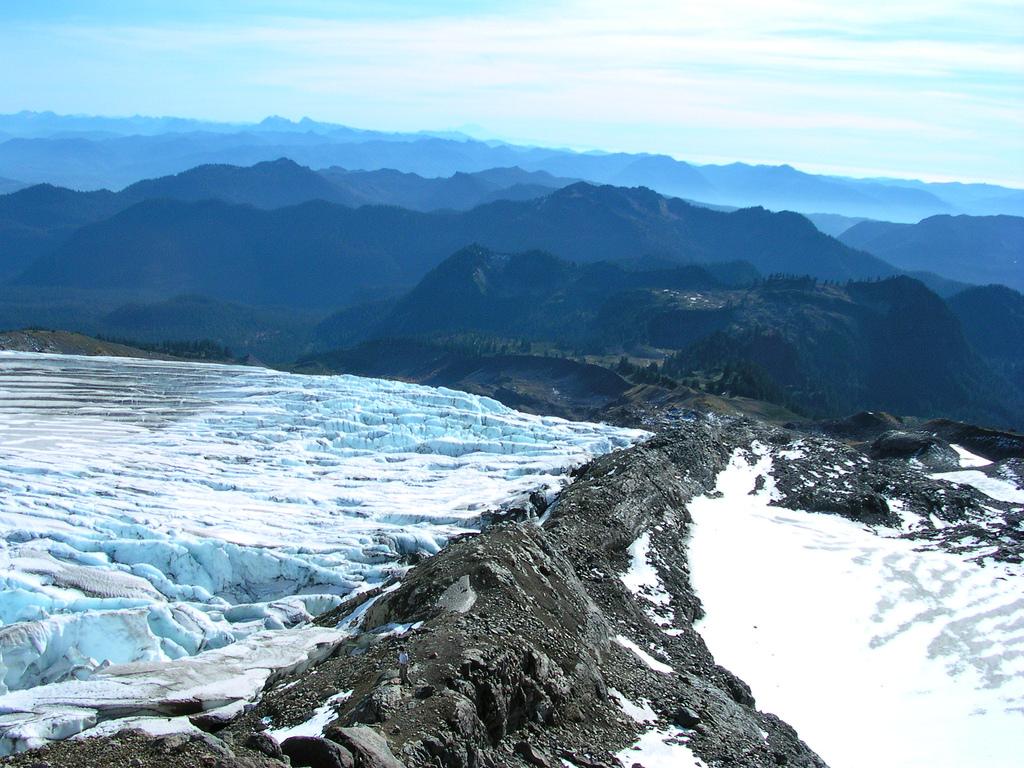How will the Pacific Northwest change when its glaciers are gone?
Photographs of the Easton Glacier on Mount Baker from the 1800s show the whole valley covered in ice. But that’s changing. Glaciers in the North Cascades have shrunk by 50 percent since 1900.
Glaciers set the Pacific Northwest apart and are essential for supplying the region’s drinking water, hydropower and for ensuring the survival of the region's iconic salmon.
But disappearing glaciers make the Northwest uniquely vulnerable to the effects of climate change. Washington has more glaciers than any other state, except Alaska. Some 376 glaciers feed the Skagit River. That number alone sets the Evergreen State apart from the rest of the country, but it also makes it uniquely vulnerable to the effects of climate change.
Glaciers provide water critical for drinking, hydropower generation and salmon survival in the Northwest.
Hiking up Mount Baker in Washington’s North Cascades, Jon Riedel pauses just shy of 4,000 feet, in the middle of a field of boulders. No glacier in sight.
“If you were here in 1907, you’d be looking right at the terminus of the glacier,” he says. Riedel is a National Park Service geologist at North Cascades National Park in Washington.
The terminus is now closer to 4,400 feet. Photographs from the 1800s show the whole valley covered in ice. But glaciers in the North Cascades have shrunk by 50 percent since 1900. Riedel says throughout history, glaciers have advanced and retreated over these mountains hundreds of times.
But now it’s different.
“The glaciers now seem to have melted back up to positions they haven’t been in for 4,000 years or more, so we’ve kind of gone beyond that natural scale of variability,” Riedel says.
The glaciers provide billions of gallons of water to rivers in the Northwest. It also adds stability to the region’s water supply. In mid-to-late- July, after the mountain snow has melted and there’s little rain, glacial melt provides the needed water.
And at the hottest, driest times of the year, glaciers are the biggest source of water for some of the streams that feed the hydropower facility at Ross Dam. The dam is one of three dams operated on the Skagit River.
“We are unique. There are not too many dams that operate in a place where some of the runoff for the project is coming from glaciers,” says Crystal Raymond, who leads the climate change research and adaptation program for Seattle City Light. The utility operates the three dams on the Skagit River that provide about a quarter of the power for the city of Seattle.
It’s Raymond’s job to figure out what to do when the glaciers are gone. She says Seattle City Light will need to change how it stores water above the dams, and possibly expand the reservoirs to capture more rainwater to save for the late summer months. Helping customers cut back on energy use is also going to be key. By the time millennials are retiring, summer hydropower production in the Northwest is expected to be down by roughly 15 percent. But Raymond is an optimist.
“It isn’t hopeless,” she says. “There’s certainly a lot of uncertainty, but we know enough now to start getting prepared and with time we’ll know more, but the sooner we start the more likely we are to reduce the impacts. And there’s no time like the present.”
Several miles downriver from Ross Dam, Erin Lowery scans the clear water for salmon nests or redds, as they’re called. He spots the dark shape of a Chinook salmon sitting on its nest.
Lowery is a fish biologist for Seattle City Light. His job is to find where salmon are spawning on the Skagit River and make sure the dams release the right amount of water to allow the eggs to incubate safely. The utility is required to manage its dams to protect spawning fish. Too much water released from the dams will wash the eggs away. Too little, and they’ll be left high and dry.
Lowery says glaciers aren’t just important because of the water they provide in the summer — it’s also because of the temperature. No glaciers means warmer rivers, and that’s bad news for salmon and their eggs, too.
Lowered temperatures in rivers that are dominated by glacial waters — or at least have a glacial component to them — is key to cold water fish like salmon, Lowery says. It hasn’t come down to a choice between fish or power yet. But he loses sleep thinking about that possibility.
“I think as we move forward, I mean, it’s going to be a hard look at how we manage flows in the river with a changing climate, with a reduction in glaciers and snowpack because people are moving to the Puget Sound constantly and they’re all going to need electricity,” Lowery says.
Scientists aren’t sure exactly when the glaciers will disappear. It could be within a few decades. It could be by the end of the century. But when they’re gone, they’ll be missed.
